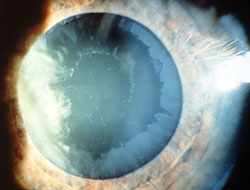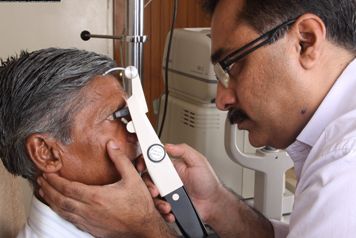-
Pseudoexfoliation syndrome (PEX)
is characterized by tiny microscopic white or grey granular flakes which are clumps of proteins within the eye which look somewhat like dandruff when seen through a microscope and which are released by cells.The abnormal flakes, sometimes compared to amyloid-like material,are visible during an examination of the lens of an eye by an ophthalmologist or optometrist, which is the usual diagnosis.The white fluffy material is seen in many tissues both ocular and extraocula in the anterior chamber structures, trabecular meshwork, central disc, zonular fibres, anterior hyaloid membrane, pupillary and anterior iris, trabecula, and occasionally the cornea.The flakes are widespread.There is some research suggesting that the material may be produced in the iris pigment epithelium, ciliary epithelium, or the peripheral anterior lens epithelium.

PEX can become problematic when the flakes become enmeshed in a “spongy area” known as the trabecular meshwork the outflow of clear fluid called the aqueous humor can be blocked resulting in an incease in internal eye pressure leading to glaucoma.
PEX is usually diagnosed by your Optometrist or Ophthalmolgist during a slit lamp examination Since the symptom of increased pressure within the eye is generally painless until the condition becomes rather advanced, it is possible for people afflicted with glaucoma to be in danger yet not be aware of it. As a result, it is recommended that persons have regular eye examinations, so that treatments can be prescribed before there is any serious damage to the optic nerve and subsequent loss of vision.

The cause or etiology of pseudoexfoliation glaucoma is generally unknown.
http://en.wikipedia.orgMore on Pseudoexfoliation Syndrome
Location & Contact Details
© 2017 - 2025 Noel Templeton Optometrists



